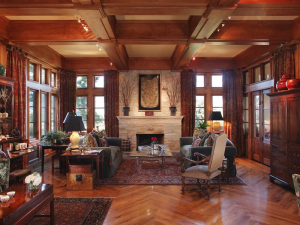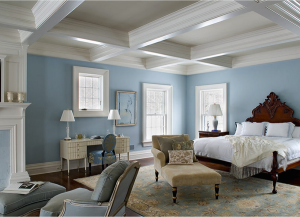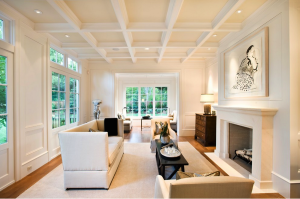Leafing through a book of historic Tuscan villas, I was struck again and again by their masterful use of coffering. The coffered ceiling—a grid of beams and crossbeams with sunken panels filling the rectangles between them—has been around since ancient Greece and Rome, when it was usually made of stone or concrete. But it made a grand reappeared during the early Renaissance, when elaborately decorated timber versions began to grace the great halls of Italian palazzos, English castles, and French chateaux. A little research showed me that, given the right setting, the coffered ceiling has lost none of its architectural power and charm. Here are three recent examples made of American hardwood that I found particularly compelling.

In the living room of a French Renaissance-style mansion in Hillsborough, CA, the coffered ceiling, window surrounds, and herringbone floor are all made of hickory.
Even though it’s located on an estate in Hillsborough, CA, you’d be forgiven for thinking this imposing yet comfortable living room is in a 17th-century French chateau. At more than 8,000 square feet, the residence certainly has the grand proportions of a Loire Valley manor, but it began life as a contemporary American home built in 1972. Its current Francophile owner has spent the last several years transforming it into a convincing replica of a Louis XIII-style country house. One of the first design strategies was to install coffered ceilings since they were a signature architectural element of the period. Stately yet simple, the box beams are made of hickory in a light honey-color finish, which helps keep them from appearing overwhelmingly massive. The same hardwood and finish are used for the window casings and frames and for the parquet floor, which is laid in a classic herringbone pattern—another signature of the period.

Benjamin Moore “Decorator White” paint is used on the custom coffered ceiling, window surrounds, and other millwork—all poplar—in this restful upstate New York bedroom, part of an addition by Crisp Architects. Photograph by Rob Karosis
Another strategy for keeping large-scale box beams from overwhelming a space—especially when it’s only 10 feet high—is to paint the entire coffered ceiling a single color. That’s what Crisp Architects have done in this master bedroom, part of an addition to a 19th-century farmhouse that’s now a country retreat in upstate New York. They’ve used Benjamin Moore “Decorator’s White,” a classic shade that’s pure without being cold. Subtle trim adorns the beams and other millwork—all of it custom-made in poplar by Feldweg & Freeman Woodworking—animating the painted elements so they feel light and elegant. Wide planks of another hardwood, black walnut, cover the floor, its warm burnished color and rich characterful grain contrasting perfectly with the room’s predominantly cool and collected palette. Rather than producing a grand effect, the coffering here creates a sense of intimacy and security. What more could you ask for in a bedroom?

An unobtrusive coffered ceiling helps create low-key drama in the quietly sumptuous living room of an Atherton, CA, house designed and built by Pacific Peninsula Group. Photograph by Bernard Andre
Understated elegance is the watchword in a new house in Atherton, CA, designed and built by Pacific Peninsula Group. The living room features a coffered ceiling that’s a model of subtlety and restraint. Although the space is long and lofty, the box beams are neither broad nor deep, so the coffers are shallow and unobtrusive. Decorative, not structural, their principal function is to break up the vast expanse of the ceiling, which would be visually monotonous—an oppressive blank rectangle—without any surface ornament. Clerestory windows at ceiling level allow natural light to play across the coffers during the day, providing a constantly changing shadow landscape. In a daring move, the maple coffering, window frames, and millwork, along with all the walls, are painted one color: Pratt & Lambert “Gray Moiré.” This creamy barely-there shade not only unifies the quietly sumptuous space but also leaves the light, textures, and proportions of the room to supply a low-key sense of drama.
Crisp Architects
3788 Route 44
Millbrook, NY 12545
crisparchitects.com
Feldweg & Freeman Woodworking
1051 Salt Point Turnpike
Pleasant Valley, NY 12569
feldwegfreemanwoodworking.com
Pacific Peninsula Group
718 Oak Grove Ave.
Menlo Park, CA 94025
pacificpeninsula.com



